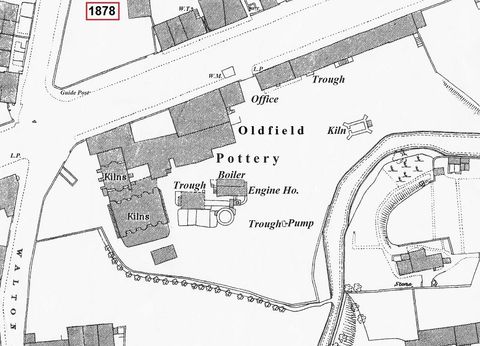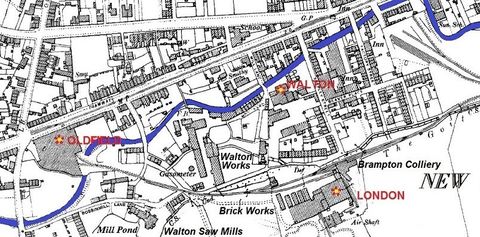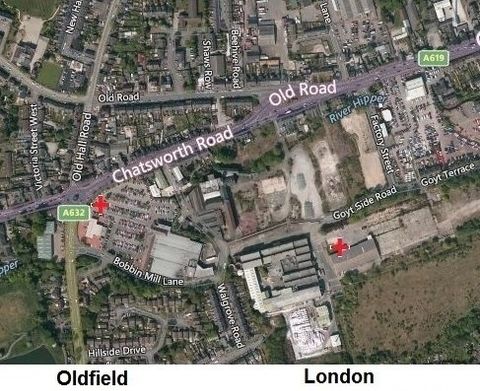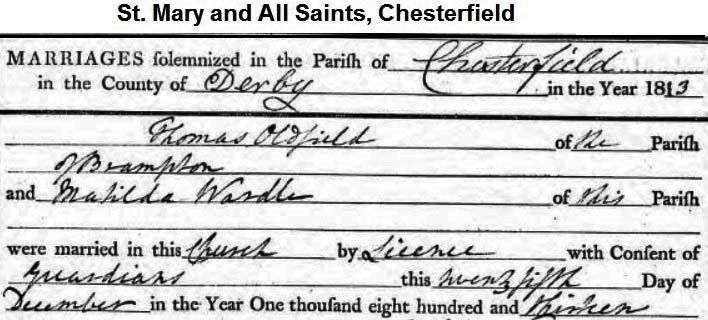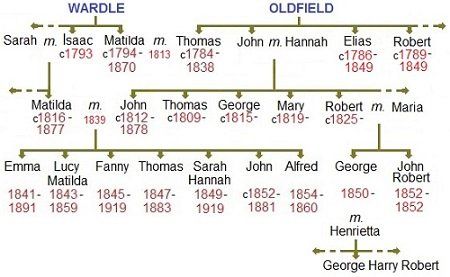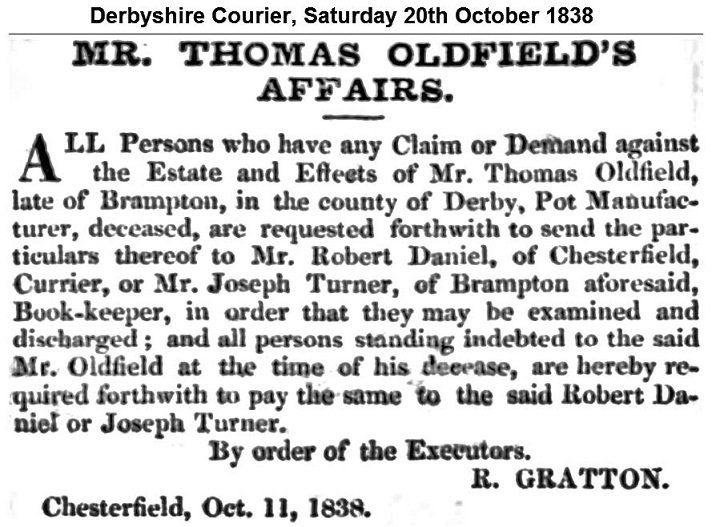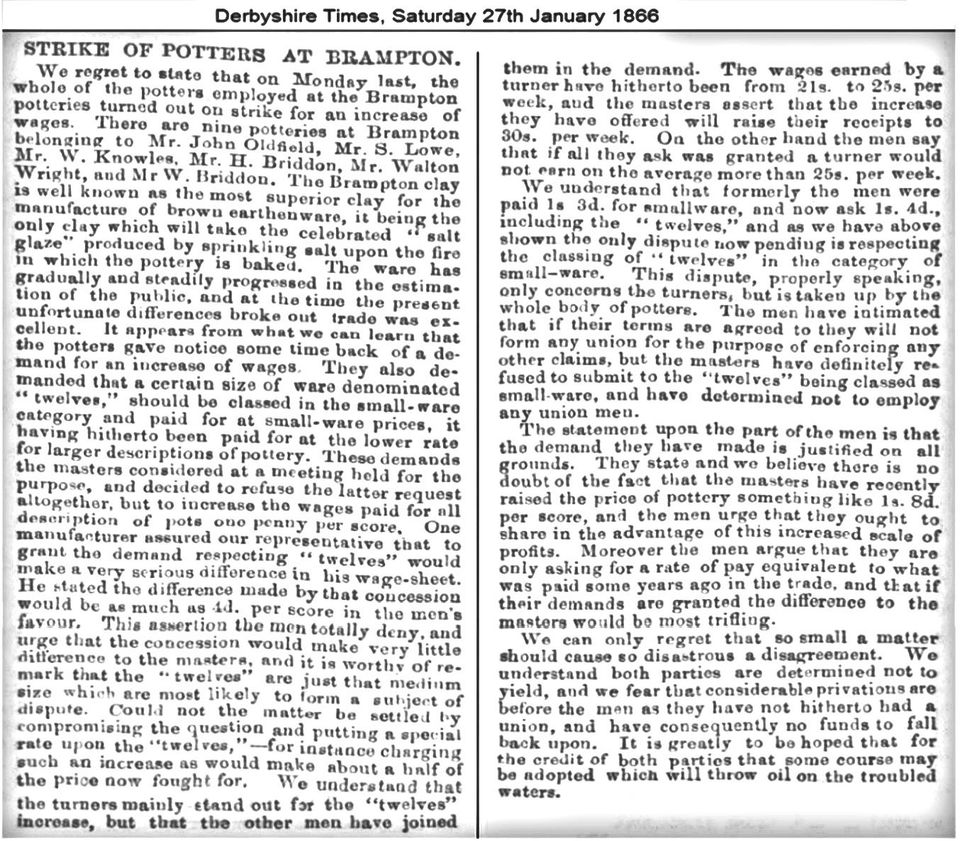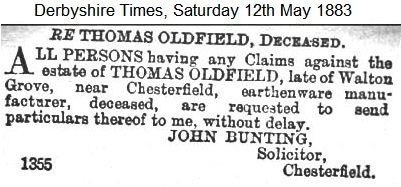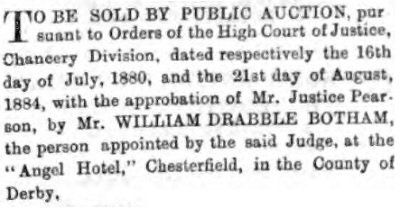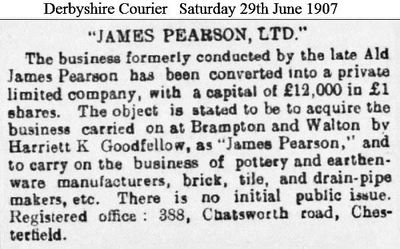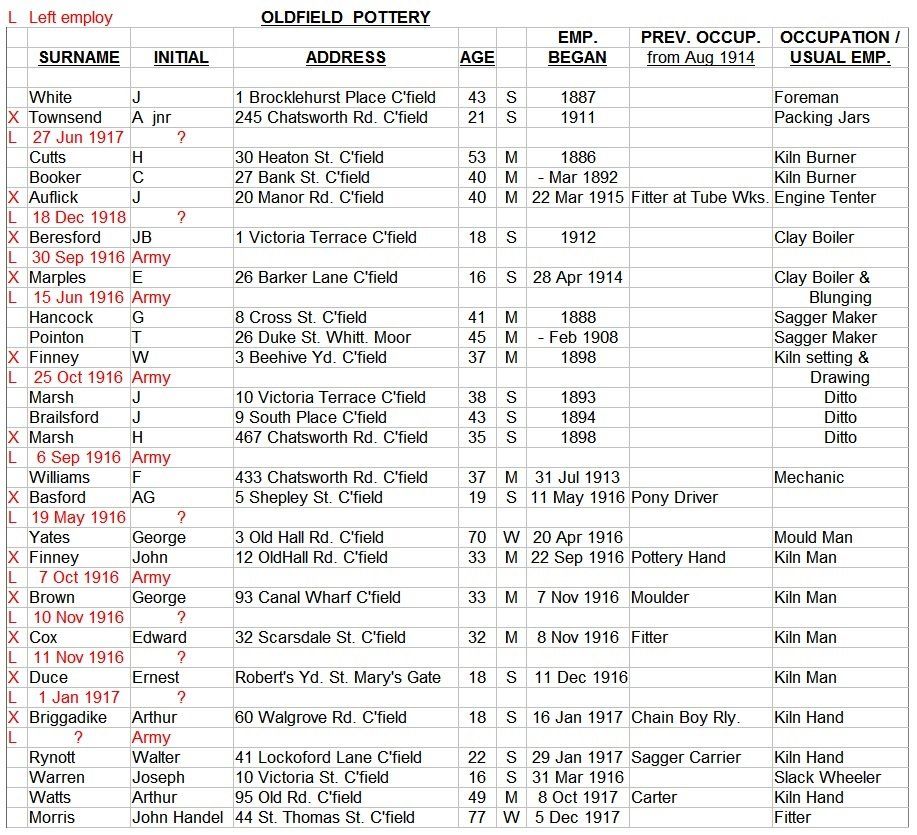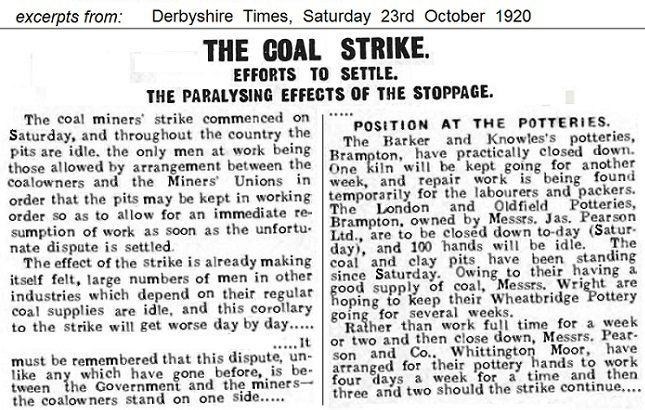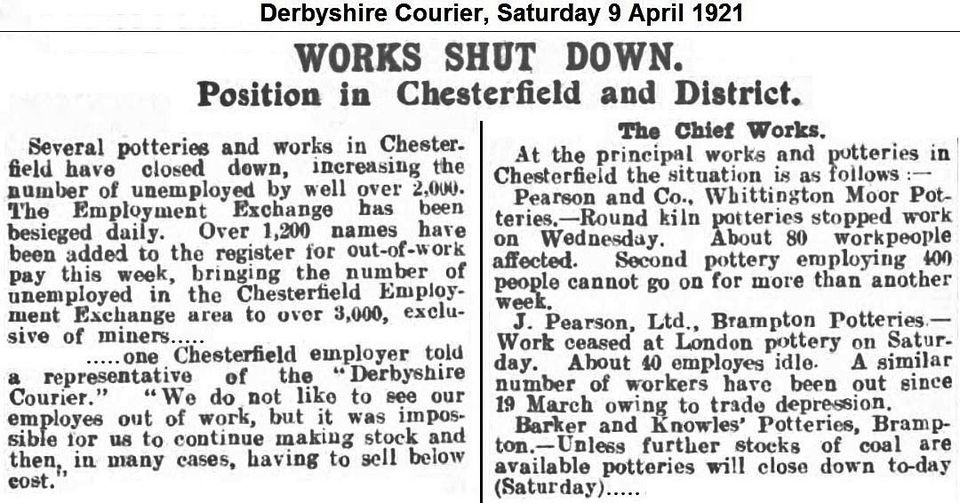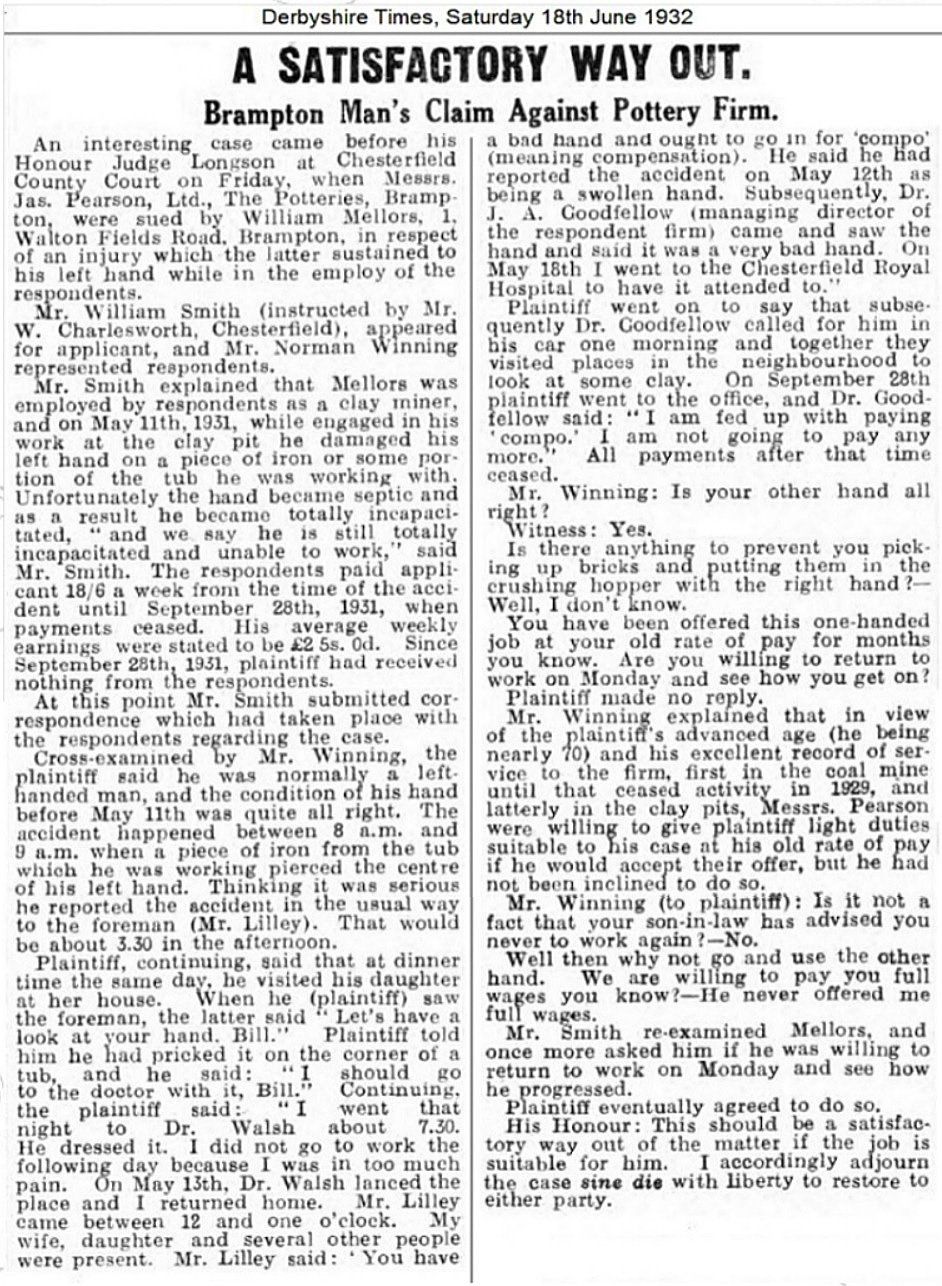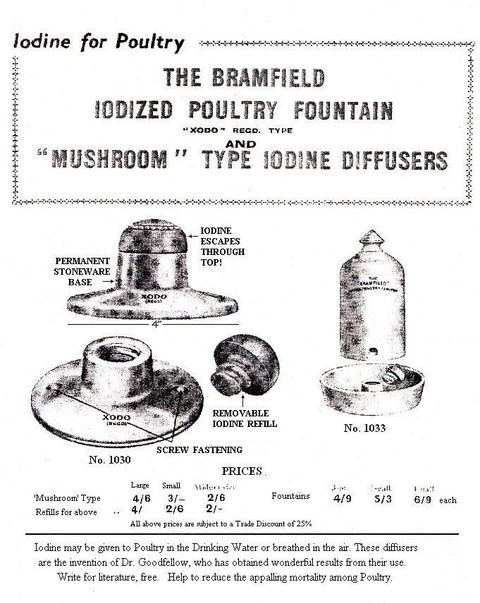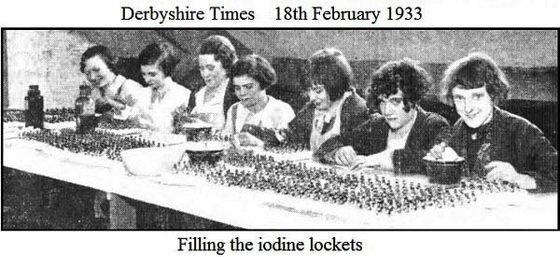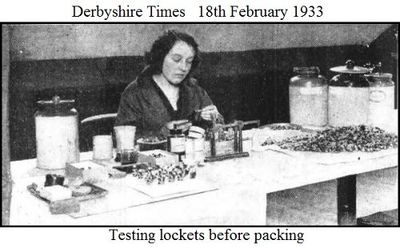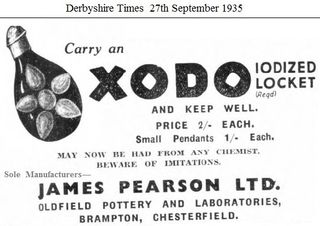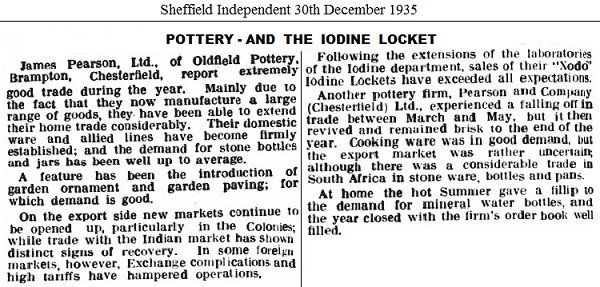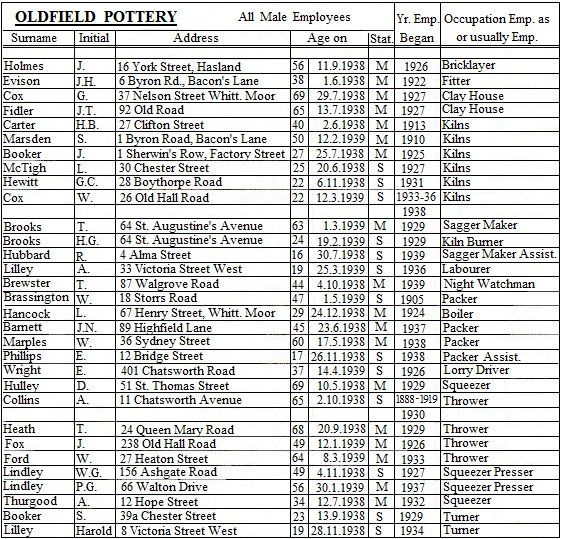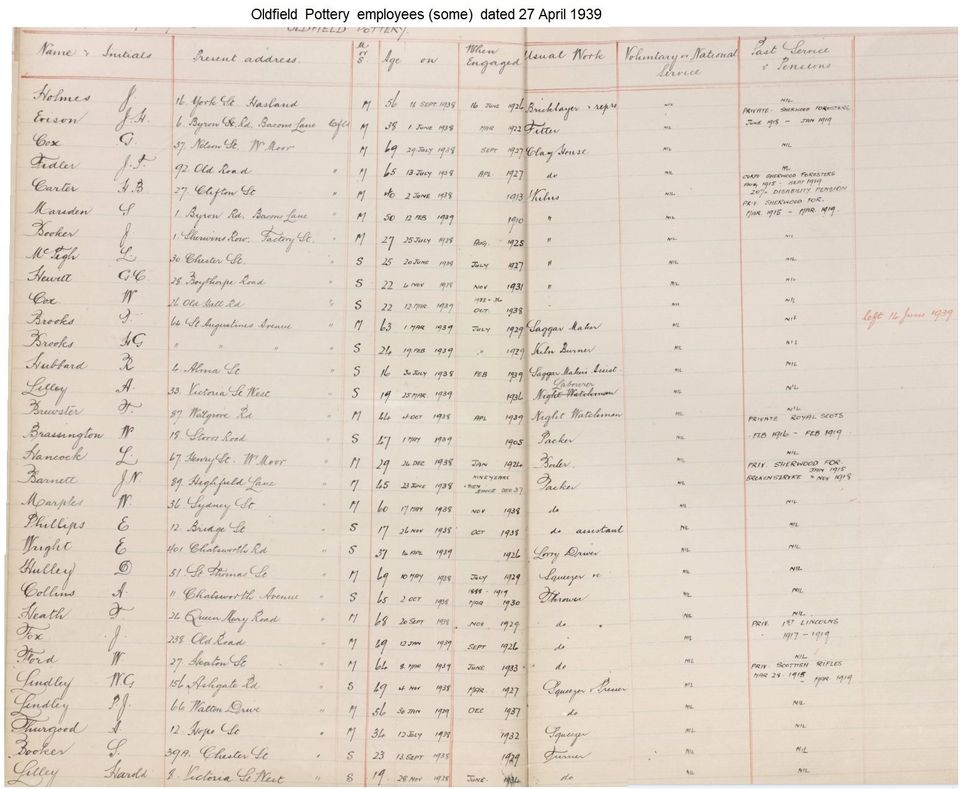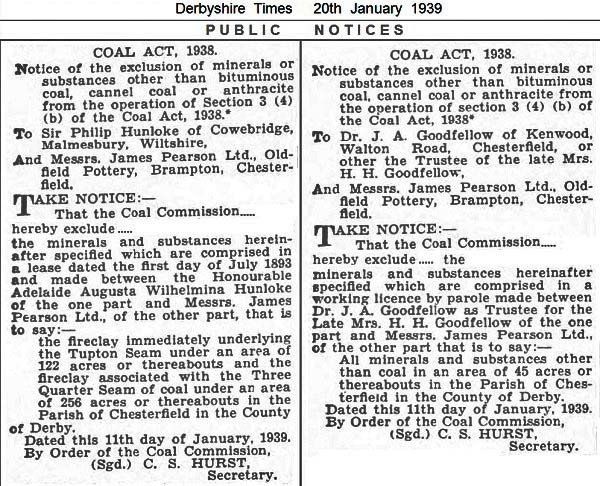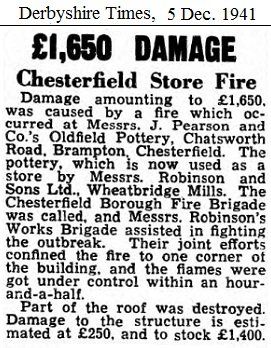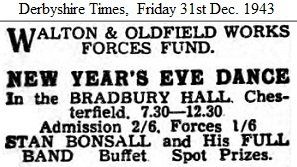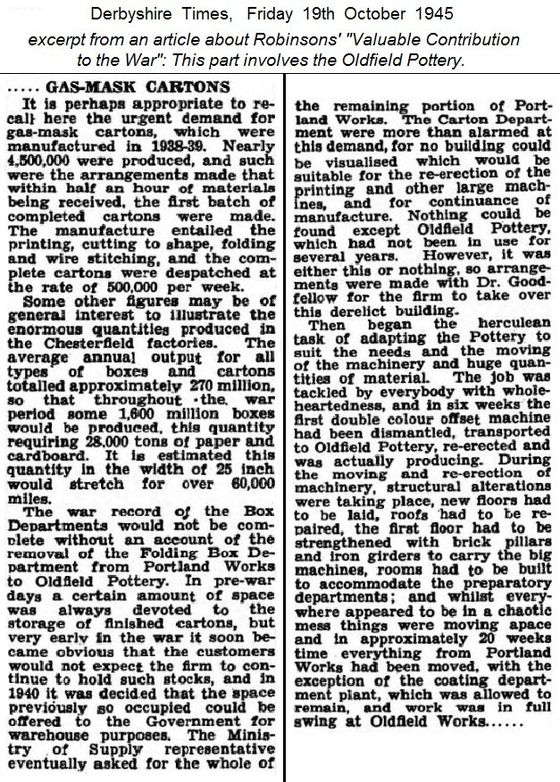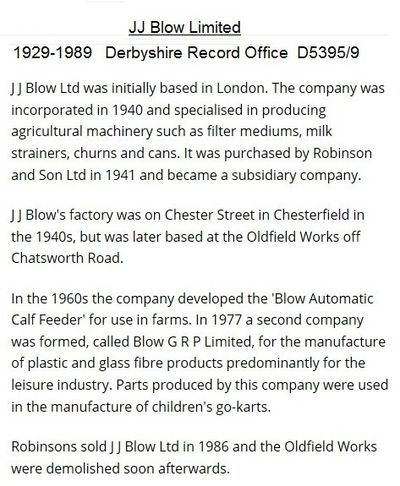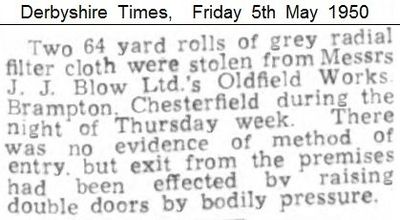Thomas married Matilda Wardle, daughter of John & Mary on the 25th December 1813; but they had no heirs.
Oldfield Pottery, Brampton
A blog about the Oldfield Pottery & the family that owned it.
Oldfield Pottery was on the corner of Chatsworth Road & Walton Road.
Above on the left, is a close up of the pottery 1878; & above on the right a
1898 map.
Below are then & now maps of the position of the pottery. c/o maps.nls.uk/gov/explore
Thomas Oldfield & Co.
-1838
John Oldfield & Co.
1838 - 1854
John Oldfield
1854 - 1878
Thomas & John Oldfield
1878 - 1883
James Pearson [Ltd.]
1884 - 1939
Robinsons
1939 - 1986
Quick Summary:
According to 'Jewitts'
the Oldfield pottery was established in
1810 by Messrs. Thomas Oldfield, Madin, Wright, Hewitt & Co. who also ran it; & was later established in
c1826 by Oldfield & Co.
Thomas Oldfield was the managing partner of the firm of Oldfield & Co. until his death in
1838; then his nephew, John Oldfield, took over. The partnership of Oldfield & Co. was dissolved in
1854 & John Oldfield ran it with his sons Thomas & John. After John died in
1878 his sons inherited it - but both of them had died by
1883.
James Pearson bought the pottery in
1884 & in the
1930's-1940's
Robinsons bought it. It was demolished c1986.
Thomas Oldfield was born c1784 & was a son of George Oldfield. He was the managing partner in the firm of Oldfield & Co. & he's in Pigot's Directory 1828-9 as a stone & ground ware, earthenware manufacturer & in Whites' 1833 as a brown & stone bottle maker, earthenware manufacturer in partnership.
Matilda was born c1795 in Newbold, Chesterfield. Her brother Isaac Wardle was born c1793 in Newbold & it was his daughter who later married Thomas' nephew John Oldfield.
Thomas died on Saturday the
16th June 1838 & was buried on the
22nd June 1838 at Sts. Peter & Paul, Old Brampton, aged 54 yrs., of Walton, Chesterfield.
Derby Mercury Wednesday 27th June 1838
Deaths:
“At Walton, near Chesterfield, on Saturday s'nnight, much respected, Mr. Thos. Oldfield, managing partner in the extensive Pottery called the New Pottery, Brampton moor, aged 55. The death of Mr Oldfield is deeply lamented by all his work-people and the surrounding neighbourhood.”
Thomas died on Saturday the
16th June 1838 & was buried on the
22nd June 1838 at Sts. Peter & Paul, Old Brampton,
aged 54 yrs., of Walton, Chesterfield.
Elias & Robert Oldfield both die in 1849 & were buried respectively on the 29th April & the 23rd of May at St. Thomas' Brampton. Elias was 63 yrs & Robert 60 yrs old, both of Brampton Moor.
John was born c1812 Dore, Dbys. to John & Hannah Oldfield; & was Baptised on the
26th January 1812 at Dore. Matilda was born c1817 Worksop, Ntts. to Isaac & Sarah Wardle.
Back to business:
Learning who to trust the hard way......
Derby Mercury, Wednesday 4th June 1845
FORGERY AND EMBEZZLEMENT.- Paul Turner, a confidential servant in the employ of Messrs. Oldfield and Co. Brampton, in whose service he has been for upwards of 20 years, absconded a few days ago from his situation. Turner had been in the habit of collecting accounts for the firm, and the greatest reliance was placed on his integrity. It has been ascertained that in one district alone he has collected upwards of £200. For which he has not accounted, but the total amount of his defalcations has not yet been ascertained, but it is supposed will amount to a very serious sum. From Mrs. Gratton, of Mansfield, who formerly resided in the town of Chesterfield, he borrowed the sum of £150 as he said, to purchase hops, and gave as a security a note of hand for the amount of £180, purporting to be signed by Mr. Oldfield, which now turns out to be a forgery. It is supposed that he has succeeded in effecting his escape to America.
By the 1851 census the family had moved to Walton Grove. John Oldfield, earthenware manufacturer, coal miner & farmer, employing 70 persons - 35 men 27 boys & 8 women. Also present was John's wife, Matilda, & their children, Emma, Lucy, Fanny, Thomas & Sarah; & Matilda Oldfield, Aunt, (widow to Thomas) Annuitant.
All the children were born in Walton & all were baptised at St. Thomas', Brampton. Emma was born 15th May 1841, Lucy Matilda,15th October 1843, Fanny 7th April 1847, Thomas 7th April 1847 & Sarah Hannah 2nd April 1849.
John's brother Robert Oldfield who was born c1825 in Dore, Dbys. was by this time living on Occupation Road, Brampton, & working as a potter. With him is his wife Maria & son George who was born c1850 at Brampton, & baptised at St. Thomas', Brampton on 23rd May 1850. Robert & Maria had one more child, John Robert, who was baptised 2nd February 1852 & buried 19th February 1852 at St. Thomas', Brampton.
The leading families & employers of Brampton organised themselves for celebrations.
John & Matilda had 2 more children, John who was born c1852 & was baptised 19th February 1852 at St. Thomas' Brampton; & Alfred who was born c1854 & was baptised 12 March 1854 at St. Thomas' Brampton.
Two of John & Matilda's children died within 15 months of each other. Lucy Matilda who was born in 1843 at Walton, died in 1859 at Walton Grove, aged 16. She was buried 2nd November 1859 at Sts. Peter & Paul, Old Brampton. Alfred was born c1854 at Walton, died c1861 at Walton Grove, aged 6yrs. He was buried at Sts. Peter & Paul, Old Brampton, on 16th January 1861.
The
1861 census shows the family still at Walton Grove: John Oldfield, earthenware manufacturer, occupying 25 acres land, employer; John's wife, Matilda, & their children, Sarah Hannah & John junr.; & also Matilda Oldfield (widow to Thomas) Fund Holder.
Robert Oldfield, John's brother, is still on Occupation Road with wife Maria & son George, but is now an earthenware pot maker: By 1863 he is John's manager of works at the pottery.
F. White's Directory 1862: John Oldfield has 2 entries one for Chesterfield & one for Walton.
Chesterfield: Coal & Ironstone Masters: John Oldfield Boythorpe
Earthenware Manufacturers: John Oldfield Brampton Moor
Walton: Colliery Owners: John Oldfield Boythorpe
Earthenware Manufacturers: John Oldfield (antique & stone ware & water filter manufacturer)
Derbyshire Times Saturday 31st January 1863
Summary
PUBLIC MEETING AT BRAMPTON.- THE GAS QUESTION
An influential public meeting of the inhabitants of Lower Brampton was held in the School Room, on Friday Evening at six o'clock. There was a large attendance, & the Rev. W. Peach was called to the chair.
Rev. Peach explained that he had reluctantly opposed the lighting in the past because a large number of rate payers would have to pay for it but would not receive any benefit. The boundary marked out at a previous meeting was different to the one marked out primarily & the one marked out now; so he now advocated it. He was aware that some little hardship & injustice upon some of the rated inhabitants would be done but he thought the scheme now proposed would entail as little of that as possible. The only property not benefited by it was the Bridge Inn, but among other owners & occupiers there was generally no argument. He then read out the area in the district to be lighted:
"The lighting will commence on a boundary on the south by the river Hipper; on the west by an occupation road leading from the bleach works of Messrs. Hewitt & Co., across the Chesterfield road, by the back near Mr. Irving's, to the footpath leading from Ashgate; on the north & east by the Ashgate road leading from Linacre brook."
Mr. M. Knowles
moved & Mr. Walton Wright seconded a resolution that the provisions for lighting should be adopted & carried out. The resolution was carried unanimously.
The Chairman
said the next proposal to be adopted was to determine how many Inspectors might be nominated to carry out the act, not less than 3 no more than 12.
Mr. T. Shipton proposed that 6 Inspectors be appointed. Mr. J. Oldfield seconded the motion. Mr. T. Shipton then moved the following persons be nominated:- Mr. Samuel Lowe, Mr. Henry Briddon, Mr. John Bradbury Robinson, Mr.
Henry Kent, Mr. Mathew Knowles
& Mr. Edley Taylor. Other candidates could be proposed with the restrictions being that they had to be rated to the extent of £15 per year, & resident within the district to be lighted. After a discussion the above gentlemen were elected unanimously.
The Chairman said the question was the sum of money to be raised to carry out the act; & if it wasn't used straight away it must be used within 12 months.
Mr. T. Shipton
said it would take six weeks to erect the lamps.
It was stated that the gas company would not be entitled to rent from that time but when the lamps were lighted.
Mr. Machin, the manager of the works said the Company would charge the same for each lamp at Brampton as it did Chesterfield, ie 50s per year.
Mr. W. Robinson moved a resolution that the money the Inspectors should have to call for in one year commencing that date, to carry out the act shall not exceed £75.
Mr. Shipton said the cost of the lighting would be 7d in the pound. The Chairman said they would be able to carry on with 5d rate when the new assessment was done.
Mr. S. Gregory seconded the motion for the call of £75 which was carried unanimously.
Mr. G. Hewitt asked if £75 was enough to light the district as it should be, & the Chairman replied the Inspectors will do it as well as they can.
Mr. Shipton, replying to a question, said it was intended to light about thirty lamps.
Mr. W. Robinson
asked if the Gas Company would charge for a year if they used the lamps less than a year: Mr. Machin
replied no.
Mr. W. Robinson
then proposed that the Inspectors be asked to commence the lighting immediately. Mr. G. Hewitt seconded the motion.
Mr. Irving
proposed a vote of thanks to the Chairman for presiding, & congratulated the meeting that the time had arrived for lighting the streets of Brampton with gas. (Cheers)
This tells you a little about the running of a pottery:
Ronald Brown, 'British Sessional Papers, House of Commons, 1863, XVIII'.
(Parliamentary Report on the Employment of Children.)
“Salt or Brown Ware, and Stoneware Potteries, Brampton, Chesterfield. Mr Robert Oldfield, Mr. J. Oldfield's Manager. We employ altogether between 40 and 50 hands. That would be about the average number employed by the other manufacturers of salt glazed and stoneware in this neighbourhood. The salt glaze is not dipped in any glaze as the white glaze is. A little slip which has no lead in it is poured into the jars to the glaze inside. The outside is glazed by the salt which is thrown into the kiln when the ware is being fired. A little lead or barytes is sometimes mixed with the glaze for the stoneware.
We employ three pressers who do not require children to assist them. We have four throwers who have two assistants. These assistants are boys or girls of about 15 to 18. It is too heavy work for young children to be of any use. We have five turners who have one boy or girl to turn the wheel for them. They ought to be 15, although it is not such hard work as turning the throwers wheel. We have three kilnsmen or firemen. Each fireman has two boys for carrying the ware and helping him in attending the fires. These boys also help the firemen in placing the wares and in drawing or emptying the oven. These boys should be between 15 and 18. We hire and pay all the boys and girls ourselves. This has always been the custom in this branch of the trade.
Boys of 15 get about 5s or 6s and the women get about 6s or 7s. We employ women to handle. Our regular hours of work are 6 a.m. to 6 p.m. with half an hour for breakfast, an hour for dinner, and half an hour for tea. We seldom have any work after 6 p.m. We have not any cause lately. The kilnsmen and their boys have to stay up through the night. One man and his two boys stay up two nights each week, when we are in full work. An oven takes about 30 hours to be fired.”
A strike at the Brampton Potteries
A strike at the Brampton Potteries
Matilda Oldfield, widow of Thomas died, aged 76yrs. at Walton Grove, Chesterfield. She was buried on
5th February 1870 at Sts. Peter & Paul, Old Brampton, Chesterfield.
John & his family were still at Walton Grove at the time of the
1871 census: John Oldfield, earthenware manufacturer employing 20 men & 25 boys & girls, John's wife, Matilda, daughters Emma, Fanny & Sarah & son John who is a book-keeper in a pottery: Son Thomas is travelling as commercial agent.
Derbyshire Times, Saturday November 17th 1877
DEATHS:
OLDFIELD:- Nov. 15 at Walton Grove, Chesterfield, Matilda, the beloved wife of John Oldfield, aged 60yrs.
She was buried on the
18th November 1877 at Sts. Peter & Paul, Old Brampton, aged 60, of Walton Grove, Chesterfield.
Her death was followed less than a year later by her husband John Oldfield. He died on
Wednesday the
24th July 1878 at Walton Grove, & was buried on the
27th July 1878 at Sts. Peter & Paul, Old Brampton, aged 66.
Derbyshire Times, Saturday July 27th 1878
Death: John Oldfield c1812-1878
LOCAL NEWS
DEATH of MR. J. OLDFIELD, OF BRAMPTON:- “We regret to announce the death, somewhat suddenly, of this gentleman, which took place at his residence on Wednesday. Mr Oldfield was well and widely known as one of the largest pottery manufacturers in this pottery district, and his demise will be regretted among a large circle of friends. Mr. Oldfield, who was 66 years of age, had been in failing health for some time, although nothing so serious as his rapid dissolution was apprehended.”
Matilda was to have £20 paid to her straight away, an annuity of £60, & furniture, household goods & effects of that nature which are in their house at his death, for her own use absolutely; also the dwelling house, close of land, garden, shrubbery & premises at Walton are to go to Matilda for as long as she lives,
“and from and after her decease I give and devise the same unto and to the use of my two sons Thomas Oldfield and John Oldfield.......as tenants in common...”
Fanny, Emma & Sarah were to receive an annuity of £40 each. If any of them had children then their children will receive a sum of money when they reach 21.
The pottery, lands & real estate go to Thomas & John as tenants in common, providing they adhere to the requests in his will.
The
1881 census shows the 4 surviving children of John & Matilda living together at Walton Grove: Thomas Oldfield, earthenware manufacturer, & his sisters, Emma, Fanny & Sarah Hannah.
As is shown a bit later, the Oldfield estate went up for sale & James Pearson ended up buying the pottery.
As for the 3 sisters, Emma, Fanny & Sarah Oldfield & their cousin George Oldfield – son of Robert & Maria Oldfield they moved out of Derbyshire to the south of England.
I mention their cousin & his occupation as I think it may have something to do with the occupations of 2 of the sisters & also it shows the line of inheritance through the male members of the Oldfield family.
George had trained as an estate agent/steward & had got married to a Henrietta Webb in
1879. They had 3 children, Lilian Martha, born c1882, George Harry Robert, born c1883 & Marie Henrietta born c1898, all born in Puddletown, Dorset, where they lived. George died on
2nd March 1913 & Henrietta died on
4th January 1958. All 3 children married.
George Harry Robert Oldfield was an architect & surveyor & a Government Valuer for the Inland Revenue. He married Marion Ellen Chase in
1912 in Bromley. When he died on
5th July 1933 he had moved back to Derbyshire & was living on Gladstone Road, Chesterfield, Dbys. His effects was £1051 17s. probate to his widow.
None of the sisters married:
Emma Oldfield died on the
9th September 1891 at the hydropathic establishment, 141 Marina Street, St. Leonard's-on-sea, Sussex. Administration on 27th November to Sarah Hannah Oldfield, effects £135 0s. 11d.
Both Fanny & Sarah were boarding/lodging house keepers on the
1901 census – Fanny in Lambeth, London & Sarah in Battle, Sussex. By
1911 they were also letting apartments – Fanny in Dulwich, Surrey & Sarah in Seaford, Sussex.
Sarah Hannah died at her sister Fanny's house, 214 Clive Road, West Dulwich, Surrey, on the
20th April 1919. Probate to Fanny Oldfield, effects £164 11s. 5d.
Fanny died just over 6 months later on the
4th November 1919 at her home. Probate was to George Harry Robert Oldfield, surveyor, her cousin George's son, effects £352 1s.
Back to the pottery 1884.
Derbyshire Times Saturday 27th September 1884
Derbyshire Times Saturday 11th October 1884
Sale of John Oldfield's Estate. In bold shows when LOTS were withdrawn. Summarized.
Only one LOT
was sold in the first sale.
1884 sale - To be sold by public auction valuable freehold properties situated at Palterton, Walton & Brampton, all in the County of Derby, by Mr. William Drabble Botham, at the Angel Hotel, Chesterfield, on Thursday the 9th October 1884, at 3 to 4 o'clock in the afternoon.
LOT 1
Stone built house & buildings, covered with tiles, & farm of arable & good grass land, situate at Palterton, Scarcliffe, Dbys., containing 53a 3r 20p or thereabouts, & let to James Farnsworth as a yearly tenant. One acre has been sold to the Midland Railway Company.
[Withdrawn at £3,000]
The minerals under about 2 acres of this property belong to His Grace the Duke of Devonshire. It is supposed the premises contains 5 beds of coal.
[Withdrawn at £1,000]
LOT 2
6 stone & brick built cottage houses covered with slate, situate on the road leading from Chesterfield to Matlock near the Blue Stoops Inn at Walton, containing 2090 square yards, & let to John Wheelhouse & others respectively at fortnightly, monthly & quarterly tenancies respectively.
[Withdrawn]
LOT 3
6 stone & brick built cottage houses covered with tiles & slate. Also a cloggers shop, yard & gardens, leading from Chesterfield to Matlock, principally in Walton with a small part in Brampton, & let to Mathew Slack & others respectively as quarterly tenants.
[Withdrawn]
LOT 4
2 stone built cottage houses & 1 brick built house with gardens, also stable boxes, shed, yard & outbuildings, cottage house & garden adjoining LOT 3. Right of footway to fetch water for cattle & other purposes from Walton Dam.
[Withdrawn at £315]
LOT 5
2 stone built cottage houses with gardens, also cottage house, stable, cattle shed & croft adjoining. Containing by measurement 1 acre & 6 perches.
[Withdrawn at £200]
LOT 6
Brick dwelling house, smith's shop, yard & premises adjoining LOT 7, & situate on the north side of the main road from Chesterfield to Chatsworth in Brampton. This property is let on lease to Frederick Clarke, from 25th September 1872, for 21 years at a yearly rent of £21.
[Sold to occupier for £405]
LOT 7
Building land & joiner's shop adjoining LOT 6
, situate on the north side of the main road from Chesterfield to Chatsworth, at the corner formed by the junction with the Old Hall Road at Brampton. Containing 4316 square yards & well situated for building. It is let to Francis Elliott & Henry Graham as yearly tenants.
[Withdrawn at £200.]
LOT 8
Field of grass land, colliery ground & spoil bank situate in Brampton, containing admeasurement of 6 acres 2 roods & 22 perches; & let to Francis Elliott as a yearly tenant.
[No offer]
LOT 9
'Brampton Museum'
built of brick with slate roof situate on the north side of the main road from Chesterfield to Chatsworth, at Brampton, containing admeasurement of 140 square yards. This property is let by subscription at a half yearly tenancy.
[Withdrawn at £100]
LOT 10
3 fields of grass land, together with Mines & minerals there-under situate near Walton Dam in Chesterfield, containing admeasurement of 16 acres & 17 perches, in occupation of the vendors.
[Withdrawn at £800]
LOT 11
Stone built villa residence covered with slate, with out premises. Lawn, kitchen gardens, vineries, orchard well stocked with fruit trees & croft. Excellent grass land. Situated on the east side of the road leading from Chesterfield to Matlock, in Walton. Within 2 minutes walk of the terminus of the Tramway from Chesterfield to Brampton, & known as 'Walton Grove'. The entire premises contain 4a 0r 16p & are in the occupation of the vendors. All coal & mining rights are reserved.
[Withdrawn at £1,000]
LOT 12
All those pottery kiln ovens, offices, outbuildings, shed, warehouses, yards etc situate at the junction of the main road leading from Chesterfield to Chatsworth, & the main road leading from Chesterfield to Matlock, with an extensive frontage to the Chesterfield & Chatsworth road in Brampton, containing an admeasurement 1 acre & 33 perches. A successful earthenware manufactory business has been carried on continuously on the above premises for nearly 100 years. The Midland Railway have a siding within 5 minutes of this place. The premises are in the occupation of the vendors, & are sold as a going concern, the business be carried on under the direction of the Court.
[Withdrawn at £500]
Particulars & conditions of Sale may be obtained in London of Messrs. Chester Mayhew, Broome & Griffiths, 11 Staple Inn, W.C.; Messrs Ullithorne, Currey & Villiers, 1 Field Court, Gray's Inn, W.C.; Messrs Pilgrim & Phillips, 19 Coleman Street, E.C., & of Mr W.H. Holcombe, Gray's Inn Chambers, 20 High Holbourne W.C.; & in the County, of Mr John Bunting, of Chesterfield; Messrs Watson, Esam & Barber, of Sheffield; Mr T.E. Jones of Manchester; of the Auctioneer at the place of sale; & of
Messrs. Black & Marshall,
Solicitors, Chesterfield
In
1884 James Pearson, eldest son of James Jervis Pearson, bought Oldfield Pottery after he left the Whittington Moor branch. [See Pearson's Pottery]
The
17th of February 1885 sees James Pearson marrying Harriett Helen Towlson, daughter of John Towlson a Cotton Doubler.
Derbyshire Times Wednesday 5th August 1885 James Pearson: Fire Oldfield Pottery
The previous Saturday about 3am a fire was reported at Oldfield Pottery: Sergeant Nicholls & some constables were despatched from Chesterfield with the curricle engine. Upon arriving they found nothing could be done except to prevent the fire spreading. They managed to do that & at 6am returned to Chesterfield.
“The building is known in the trade as the dry ware stove, in which were a number of pots in the process of drying before being burnt, and above this was a store room which contained a large quantity of pots and jugs. All these and the building in question were destroyed, and there now remains the bare walls and some charred beams. Fortunately the brigade were able to obtain a good supply of water from the main or the fire might have resulted much more seriously. We understand the property is insured but in what office we have been unable to ascertain.”
Derbyshire Times Saturday 2nd July 1887 James is making a go of his business at Brampton & expanding:
WANTED a number of YOUTHS, (over 18 years of age), to make jars, night shift from 6pm to 5.30 am; no previous knowledge required, piece work.
Apply James Pearson, pottery Brampton.
Derbyshire Times Wednesday 30th May 1888
GRAVEL for GARDEN WALKS, a supply of Clean, Sharp Gravel always on hand at Pearson's Pottery, near Tram Terminus, Brampton. Price 1s 6d per ton.
On the
1891 census James Pearson, his wife Harriet, & mother in law Christiana Towlson, are living in the Manor House, Brampton.
Derbyshire Times Saturday 1st June 1895 James is in trouble under the Factory Act. [Summary]
A case under the Factory Act was heard at the Chesterfield Borough Court on Thursday. The prosecutor was Commander Smith, H.M.L., of Sheffield & the defendant was Mr. James Pearson, Oldfield pottery owner, Brampton. The case was heard by Alderman Dr. George Booth & Mr. James Haslam.
The charge was that Mr. Pearson committed a breach of the 3rd section of the Factory & Workshops Act 1878, by employing three young persons, Charles Mason, Leonard Walker & Winfield Turner, after hours during which they could be engaged at the pottery.
On Saturday the boys should be employed from 6 or 7 in the morning until 2 o'clock in the afternoon. On Saturday 4th May assistant inspector Mr. F.J. Parkes, visited the pottery & the boys were working & it was passed 2 pm.
Mr. Pearson said his manager had told him the boys were making up for lost time because beause they had been idle & the stuff they were using would've been spoiled if they had left it.
The bench fined Mr. Pearson 1s & 12s 6d costs in each case.
Life - & tragic death sometimes - carried on in the potteries.....
Derbyshire Times Saturday 5th August 1899
BRAMPTON WAKES, AND ITS CONSEQUENCES
There were 3 summonses entered for Thursday's Chesterfield Borough Court arising out of holidays taken after the Brampton Wakes. Mr. James Pearson was the complainant, & the defendants were Walter Bower, of Alma Square; Thomas Wetton, of Prospect Street; & Clara Bennet, of Alma Square; who were summoned under the Employer's & Workmen's Act for having absented themselves from work without giving the customary seven days notice.
The case of Clara Bennett was taken first, & Mr. Black, in the employ of Mr. Pearson, said that the defendant was employed by the Pottery up to June 30th. The Pottery then ceased work for Brampton Wakes, & they had to stand a week much against their wish. Bennett gave no notice & had not yet returned to work.
In answer to the Bench, Mr Black said if they dismissed a person at a moment's notice, unless it was for insubordination, they would pay a week's wages..........
A witness said he could produce dozens of 7 day notices received from employers & swore that it was generally understood at the Pottery.
Bennett was fined 2s 6d & ordered to pay damages of 2s 6d, & costs. Walter Bower had the same judgement but the case against Wetton was withdrawn.
The Bench intimated that in their opinion printed rules should be posted up in the Pottery showing what notice must be given on either side.
Sheffield Daily Telegraph Thursday 16th August 1900
BURIED IN A CLAY PIT NEAR CHESTERFIELD.
A fall of "bind" occurred yesterday at a clay pit at Walton, belonging to Mr. James Pearson, colliery owner & earthenware manufacturer, completely burying a man named Richard Buxton, aged 45, of Britannia Street, New Brampton. He died from suffocation.
1901 arrives & James Pearson is still at the Manor House in Brampton with his wife Harriet & mother in law Christiana Towlson; but now he has a son James Alan, & a daughter Doris Christine.
Derbyshire Times, Wednesday 17th September 1902
Advert
STABLING Accommodation to Let, situate in Bobbin Mill Lane, Brampton; rent moderate.
- Apply James Pearson, Oldfield Pottery, Chesterfield.
Friday
5th May 1905 sees the death of James Pearson & another bench mark of the potteries' history.
James Pearson died after a short illness & was interred in the Churchyard at Old Brampton on the 8th. In his will, dated
15 February 1896, he leaves,
"all my real and personal estate of every description unto my dear wife Harriet Helen Pearson absolutely". The Will was proved
3rd July 1905. One of the witnesses to his Will being James Anderson Goodfellow, of Old Road, Chesterfield, Physician & Surgeon.
On the 2nd April 1911 Harriet Helen & husband James Anderson Goodfellow are living at Grove House, Ashover, near Chesterfield. James is a 'medical practitioner', although by then he had given up practice & was in bad health. With them is Doris Christine Pearson, Harriet's daughter by James Pearson, & Harriet's son by James, James Alan Pearson, is away at preparatory school in Worcestershire.
Military Service Act 1916. Conscription.
The Government introduced the Military Service Act on
27 January 1916. All voluntary enlistment was stopped. All British males were now deemed to have enlisted on
2 March 1916 if they were aged between 19 and 41 and resided in Great Britain (excluding Ireland) and were unmarried or a widower on
2 November 1915. Conscripted men were no longer given a choice of which service, regiment or unit they joined, although if a man preferred the navy it got priority to take him. This act was extended to married men, and the lower age dropped to 18, on
25 May 1916.
Employers were to keep registers or information on their employees: This included Messrs Pearson & Co. Whittington Moor & James Pearson Ltd., Brampton, potteries.
The following are registers of all male employees over 16 years of age at James Pearson Ltd.
There are more details I haven't noted in the Local Studies dept. of Chesterfield Library.
Derbyshire Courier, 19th October 1916
WANTED.- Kilnmen over military age. Good wages to suitable men - Apply Pearson's Pottery, Brampton.
The 1920's were a bad time for the pottery trade & the Oldfield Pottery. First a strike, then a lull in trade helped cause the owners to try to sell it.
Derbyshire Courier, Saturday 22nd January 1921
POTTERIES CLOSE DOWN
Work Suspended for a Week at Brampton.
A notice has just been posted at the Brampton pottery of Messrs. James Pearson Ltd., stating that the works will close down today (Saturday) until a week on Monday, and that until further notice the potteries will work only alternate weeks.
This step is stated to be due to a slump in the demand for stoneware, which is the chief output of the potteries.
About 150 men, women and girls are affected.
Sheffield Independent, Wednesday 31st January 1923
WORKS FOR SALE
CHESTERFIELD.- DISUSED POTTERY for Sale; are (Land and Works) nearly 3 acres; valuable frontage to two main roads; fireproof construction, gas, water, electricity; Midland Railway extension into works; river included; Boiler and Engine can be purchased; immediate possession; could be adapted for almost any purpose, foundry, engineering motor works, laundry, bakery etc. - For further particulars apply James Pearson, Ltd., Oldfield Pottery, Brampton, Chesterfield. 593
Claiming 'compo' & working until you're 70
Experiments were coming to fruition.... iodine health products
Derbyshire Times, 18th February 1933 James Pearson Ltd Oldfield Pottery
Dr. J.A. Goodfellow, managing director of James Pearson Ltd. has, after years of experimenting with iodine, & with his knowledge of the pottery process, created a way for iodine to be harnessed & slowly released, via lockets, buttons, brooches & candles etc. His work began in 1922 when he started to research goitre, which was common in Chesterfield & district.
The new department at the Oldfield Pottery has been working at full pressure to fulfill large orders of the product. The 'magic charms' received tremendous publicity during the influenza epidemic, throughout the Country & from abroad.
The Testing
In 1931 a special clay was prepared with the right amount of required porosity so as to slowly emit the iodine. Dr. Goodfellow made a number of lockets filled with iodine which were part glazed – the iodine being released from the un-glazed part, & they were worn from 3 months to 18 months. Dr. Kenneth Fraser, the County Medical Officer for Cumberland, distributed 650 lockets throughout 54 schools, & the outcome to the testing was that they were seen as beneficial to health.
How long does the iodine last?
Dr. Goodfellow has the degree of porosity of the clay, used for the lockets, under absolute control. The lockets, brooches & buttons diffuse some half to one grain of iodine per week for, 3 to 6 months.
The larger candles & the 'mushroom' type diffuser will prove effective for about a year. The latter type, which is fitted in Chesterfield Corporation buses, consists of an iodine filled porous stopper, which screws into a holder. In this way the stoppers may be replaced when the iodine content has been diffused at the end of 12 months. Iodine diffusers are also being fitted throughout the buildings of the Chesterfield Picture House Ltd.
The firm has also produced & patented a fowl fountain, which has been designed to give the requisite amount of iodine without trouble: It's an ordinary bell-shaped fountain with the saucer, but in the latter & forming part of it is a porous bottle with iodine firmly secured inside.The bottle is easily recharged with iodine.
How They're Made:
A fluid mixture of clay & water is poured into absorbent moulds, & allowed to set. The rough lockets are then removed from the moulds & trimmed by hand. After glazing, a girl scrapes the glazed surface from the design to permit the exit of iodine. The lockets are then 'fired', & are afterwards filled with solid iodine, hermetically sealed, & wrapped in cellophane.
The clay used is Tupton clay, of a superior quality, from the firm's own pit. Different clays vary in plasticity, & in the hardness, colour & texture of the finished product, through an extremely wide range. The clay is first ground & then thrown into a large steel vat, in the centre of which revolves a shaft with powerful arms. Water is added & the clay is mixed into a 'cream', or 'slip'. When the 'slip' has reached the requisite degree of fineness, it is run off from the vat & sifted to eliminate all foreign matter. Thence it passes in a liquid state, into wells, & from these it is pumped into clay presses, which press out the water.
The next stage is the 'pug' mill where it is needed into a uniform consistency. It is now in a workable condition.
Some types of pottery are 'thrown' on a potter's wheel, & others are made by pressing & moulding. There is also a machine method of manufacture termed 'jollying'. 'Casting' is the latest process, & is now largely used in these works.
In the 'throwing' method a girl weighs out the clay & passes it to the potter who slaps it onto his wheel, which is a horizontal, revolving disc, pivoted on a central point. With a dexterity & swiftness, the craftsman shapes it & fashions it into a symetrical & perfectly proportioned pot. Some pots are roughly shaped on the wheel & partly dried before being finished on a second visit to the wheel.
'Jollying' is a much newer method. The clay is placed in rotating moulds, & the girls in charge of the machines gauge the moment when the proper dimensions are reached. These are finished off on lathes.
After drying, the vessels are glazed by dipping or spraying – the latter method will soon be exclusively employed in these works.
The last stage is the 'firing.' The vessels are placed in 'saggars' – fire-clay receptacles which are passed into the kilns & baked.
The vessels have now only to be tested for flaws.
The Oldfield kiln flats at Brampton Moor are mentioned in a book of 1636, & the present pottery dates back over 100 years. Mr. James Pearson was the founder of James Pearson Ltd. & the present managing director, Dr. Goodfellow, has been assiociated with the business since the founder's death.
James Pearson Ltd. are reviving the production of the old Toby jugs, which are being made from the moulds used by the pottery 70 years ago. Among the specialities of the firm may be mentioned the 'Bake-well' cooking ware, which, with ordinary care, may be used on an open flame. In addition to all kinds of cooking ware, jugs, bread pancheons, basins, jam jars, & jars for fruit preserving James Pearson Ltd also make a variety of bottles for the wine, spirit, mineral water & vinegar trades; foot-warmers; speical stoneware of all descriptions for export; drinking fountains & bowls for poultry & pets; acid jars & other stoneware for chemical manufacturers; & bulb bowls, vases & cemetery crosses for florists.
(See products of James Pearson end of Pearson Potteries 1933-1994)
A list of workers 1938 / 39 (May not be complete)
By
19th May 1939 the Oldfield Pottery had changed hands. It had been in difficulties & needed fresh capital to modernise & carry on the business. Dr. Goodfellow had kept the firm afloat with the sale of iodised products in recent years but it was not enough. It was arranged that the control & management of the stoneware business will pass into other hands; & the iodine department will be completely separated from the stoneware business. Dr. Goodfellow's association with the business will be one of an Honorary Consultant only.
Dr. James Anderson Goodfellow, of Kenwood, 175 Walton Rd., died on the
1st May 1950; his wife Harriet Helen having died in
1929. His effects were £5,637 14s. 4d.
End

